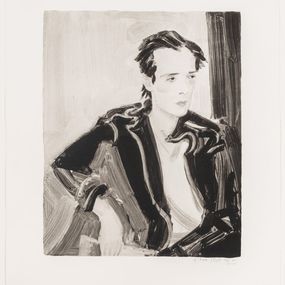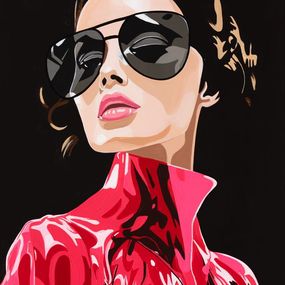
Joseph Beuys: State I (FS II.242),
1980
Andy Warhol
Print : Screen Print
102 x 81 cm 40.2 x 31.9 inch
Free returns within 14 days
Authenticity guaranteed
Learn moreSecure payment
About the artwork
Type
Numbered and limited to 150 copies
1 copy available
Signature
Hand-signed by artist
Authenticity
Sold with certificate of Authenticity from the gallery
Invoice from the gallery
Medium
Dimensions cm • inch
102 x 81 cm 40.2 x 31.9 inch Height x Width x Depth
Support
Framing
Not framed
Artwork sold in perfect condition
Artwork location: Germany
This striking artwork features a repeated portrait of a man in a classic pop art style. Presented in a grid of four identical images, the subject is depicted wearing a dark hat, set against a vibrant turquoise background. The use of bold, contrasting colors creates a mesmerizing visual effect, drawing attention to the stark features and expression of the individual. The repetition emphasizes the iconographic nature of the piece, a hallmark of the pop art movement, challenging perceptions of identity and mass media. The simplicity of the composition is juxtaposed with the complexity of its cultural commentary, inviting viewers to explore themes of celebrity and commodification. The artwork's vivid palette and distinct style make it an unmistakable example of contemporary art's exploration of repetition and identity.
Joseph Beuys (State I) is an original screen print by Andy Warhol from 1980. Joseph Beuys continually expanded his definition of art by staging “happenings” and “actions” that were never intended to last. Best known is his performance How to Explain Pictures to a Dead Hare, in which the artist, whose head was inexplicably covered in honey and gold leaf, literally carried a dead hare around with him as he traversed a gallery space that was partially inaccessible to the public.
In a way, Joseph Beuys was trying to achieve the opposite of Andy Warhol. With his bizarre performances and cryptic artworks, he attempted to create new mythologies and break away from the materialism that Warhol freely toyed with. This tension between the artistic approaches of the two artists offers an interesting perspective on the representations of Beuys and Warhol.
Joseph Beuys FS II.242 itself is quite unambiguous. Four stagings of a high-contrast and heavily shaded photograph (fairly typical of Warhol’s photography of the time) lie on a soft cyan gradient. In the photograph, Beuys is wearing his iconic fishing vest and fedora. His gaze is captivating as the borders of the sclera of his eyes merge with the rest of his face, leaving behind piercing pupils. His expression is neutral, suggesting either indifference or deep thought. His gaunt and Teutonic features make him appear almost alien, perhaps appropriate for an artist whose work is situated on the edges of intelligibility. At the same time, Andy Warhol makes Beuys a Warhol, paying him due reverence, as he does to his other works, which are considered shrines to celebrity, but also anchoring him in the material world. In Joseph Beuys State I (FS II. 242), Warhol makes Beuys tangible, almost approachable.
Andy Warhol and Joseph Beuys met for the first time in Düsseldorf in May 1979. Around seven months later, they met again in New York, which led to a “click” (Beuys) between the two artists. Warhol took almost a hundred Polaroid photographs of Beuys and chose one of them as the basis for a total of nineteen screen prints, which he presented a year later at the Schellmann & Klüser gallery in Munich. The artists traveled to Munich especially for this almost historic event and gave interviews before their “co-production” – an event that embodied the fascinating interplay of real and supposed contrasts between the two personalities and offered both amusement and profundity. The star staged himself, while the shaman revealed himself. It was well known that Beuys explored every object in detail as the energy carrier of his story, while Warhol cultivated the surface in depth. One could experience how precisely Beuys conveyed his entire artistic concept, while Warhol skillfully talked past the questions posed.
Warhol, whose fame seemed to be fading as people thought they had seen through his “American” scheme, portrayed Beuys, who was currently in vogue due to his exhibition in America. Warhol depicted the image of the European artist using his tried and tested screen printing technique, which had already proved its worth for his “American” subjects, from soup cans to the Mona Lisa. In contrast to his portraits from the seventies, however, he completely dispensed with “make-up” and did not emphasize lips, eyes or decorative elements, nor did he use areas of colour. This resulted in Beuys portraits in black on white, black on black, black on red and red on green. He enriched Warhol’s spartan mode of expression with an effect that oscillates between kitsch and subtle aesthetics. He experimented with diamond dust, which he added to the paint so that the pictures “shine, really glitter” (Warhol). Is this an arbitrary, image-enhancing effect, because “Beuys really is a shining apparition that just shines”, or does Warhol see the technical means as an expression of dignity?
The peculiarity of Warhol’s work is based, as Beuys put it, on the impossibility of clear categorization: “Even when Warhol speaks a lot, he erases the content of his information through thousands of contradictions that he builds up. Even when he speaks, he remains silent.” Beuys recognized in Warhol’s art, which uses advertising techniques, the erasure of the original information content: “In this way he brings destruction, Americanism, to the absolute zero point at which every tradition ends.” Despite this apt analysis, Warhol maintained that these pictures would be suitable as advertising: “I also think that the pictures make a great advertising poster. And since I think Joseph should really stick to his politics, these pictures would make a good poster.” Although this sounds like a constructive statement, the exchange between the artists and the portrait shows that both recognized exactly how they are reflected in the mirror of the other: The contrasts are both resolved and reinforced, and their own respective images are promoted.
About the seller
FRANK FLUEGEL GALERIE • Germany
Artsper seller since 2014
Vetted Seller
Top Seller
This seller rewards your purchases of multiple artworks

Discover more by the artist
Presentation
Born on August 6, 1928, in Pittsburgh, Pennsylvania, Andy Warhol is an American painter who revolutionized art from the 1960s to the 1980s, becoming a true legend today.
His real name was Andrew Warhola, and he began his career as a commercial artist. The son of Czech immigrants, he studied at the Carnegie Institute of Technology from 1945 to 1948, where he discovered advertising. He worked for Glamour, Vogue, The New Yorker, and Harper's Bazaar magazines. It was during this time that he began calling himself Warhol. A socialite and eccentric publicist, Andy Warhol left his mark on contemporary art. A leading figure in Pop Art , he understood, before many, the importance of the image in consumer society.
But he quickly abandoned comics, discovering at the exhibition of the famous Leo Castelli gallery, that Roy Lichtenstein had preceded him in this path.
More than twenty years after his death, Andy Warhol remains one of the most influential figures in contemporary art and culture. Warhol's life and work inspire scholars and creators worldwide with his enduring imagery, his personality, and the celebrity image he created for himself. His work continues to be the subject of research by art and cultural scholars. His impact as an artist extends beyond the "15 minutes of fame" of his famous observation: "In the future, everyone will be entitled to 15 minutes of world fame." His curiosity led to a body of work that spans all media and has contributed to the collapse of the boundary between elite and popular culture.
Andy Warhol chose to make reproductions of mass-produced, mass-market products. screen printing . He made Campbell packaging and Coca-Cola bottles the stars of his paintings. He stigmatized American consumer society and the standardization of products. His visuals quickly achieved great success.
In 1962, in addition to Campbell's soups, he revisited photos of stars such as the now famous series that later inspired so many paintings of Marilyn Monroe. His technique was to take black and white photographs , color them, and then reproduce them using screen printing, starting with his own self-portraits. Andy Warhol became the king of Pop Art and reigned over the New York underground scene. Portraits of Elizabeth Taylor, Elvis Presley, and Marlon Brando passed through the artist's hands.
With a keen business sense, Andy Warhol recruited a battalion of assistants in 1963, to whom he delegated the mass production of his creations. He moved into the "Factory," an industrial space that became his studio. The space, whose walls were covered in aluminum foil, became the center of New York's underground life. Andy Warhol made his first films there (Eat and Kiss). He also became interested in the world of music and in 1965 produced the rock band The Velvet Underground, for whom he also designed the album cover.
In 1967, he was the victim of a premeditated assassination attempt by feminist Valérie Solanas, who was one of the actors in his film of the moment, “I, a Man." She declared that “he had too much influence on my life."
Andy Warhol resumed his pictorial activity during the 70s and produced series based on Mao, Mick Jagger, Cassius Clay or commissioned portraits: Ladies and Gentleman, 1975. Often nicknamed the Pope of Pop Art, he encouraged New York artists such as the painter Jean Michel Basquiat, the singer Lou Reed and the photographer Robert Mapplethorpe in the early 80s. The genius of Pop art died on February 22, 1987 following an operation.
What should we see in Warhol's work? A reflection of an era, of a society? A great cynicism? "If you want to know everything about Andy Warhol, you only have to look at the surface of my paintings, my films, of me. There I am. There's nothing underneath."
Movement Pop Art
American Icons
Printmakers
Designers
American artists
More works from FRANK FLUEGEL GALERIE
This seller offers discount when you purchase multiple artworks!
Artsper delivers internationally. The list of countries is available in the first step of your cart.
If your country is not listed contact us at [email protected] and we will see what we can do.
Note that Customs fees may apply for works shipped internationally. This is indicated in the first step of the shopping cart.
You can choose a delivery address different from the billing address. Make sure that a trusted person is present to receive the work if you cannot be there.
Have you purchased a painting, sculpture or work on paper?
Find our expert advice for the conservation and promotion of your works in the articles below:
Artsper offers you access to more than 200,000 works of contemporary art from 2,000 partner galleries. Our team of experts carefully selects galleries to guarantee the quality and originality of the works.
You benefit from:
-
Works at gallery price
-
Return within 14 days, regardless of your location
-
Easy resale of the work purchased on Artsper
-
Personalized research tools (selection and tailor-made universe)
Our customer service is available for any assistance.
At Artsper, our mission is to allow you to collect works of art with complete peace of mind. Discover the protections we offer at every stage of your shopping experience.
Buy works from top galleries
We work in close collaboration with carefully selected art galleries. Each seller on Artsper is carefully examined and approved by our team, thus ensuring compliance with our code of ethics. You therefore have the assurance of purchasing authentic, high-quality works.
Total transparency: you know what you are buying
Before being posted online, all artwork on Artsper is reviewed and validated by our moderation team. You can browse with complete peace of mind, knowing that each piece meets our criteria of excellence.
Personalized support: our experts at your service
Our team of contemporary art experts is available by phone or email to answer all your questions. Whether you want advice on a work or a tailor-made selection to enrich your collection, we are here to support you.
Resell your works with ease
If you have purchased a work on Artsper and wish to resell it, we offer you a dedicated platform to relist it. To find out more, click here.
Make offers with Artsper: negotiate like in a gallery
You have the possibility to propose a price for certain works, just like in a gallery. This feature allows you to initiate discussions and potentially acquire your coins at advantageous prices.
Get help with your negotiations
Our team will negotiate for you and inform you as soon as the best offer is obtained. Do not hesitate to call on our expertise to ensure a transaction at the best price.
Order securely
Artsper satisfaction assurance
We want you to be completely satisfied with your purchase. If the work you receive is not to your liking, you have 14 days to return it free of charge, and you will be refunded in full, whatever the reason.
Secure payment with Artsper partners
All credit card payments are processed by Paybox, the world leader in payment solutions. Thanks to their strict security standards, you can transact with confidence.
Problem Support
In the rare event that an artwork arrives damaged or not as described, we are here to help. Whether for a return, refund, restoration or exchange, our team will support you throughout the process and will ensure that we find the solution best suited to your situation.
Conditions to benefit from Artsper protections:
-
Use one of the payment methods available on Artsper for your order.
-
Report any problems within one week of receiving the work.
-
Provide required photographic evidence (including original artwork and packaging).
Artsper guarantees cover the following cases:
-
The received work lacks a described characteristic (for example, a signature or frame).
-
The artwork has significant differences from its description (e.g. color variation).
-
The work is damaged upon receipt.
-
The work is lost or damaged by the carrier.
-
Delivery is significantly delayed.
With Artsper, you collect with complete peace of mind.






















